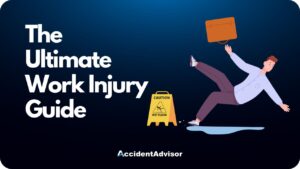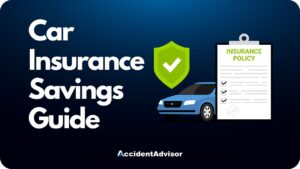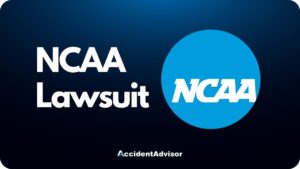Determining fault in a car accident is a complex endeavor, influenced by many parties with different sets of information. These include police, juries, insurance companies, and witnesses. However, the insurance company ultimately determines fault.
With around 43,000 people dying in motor vehicle crashes every year, an at-fault car accident can hold very different financial implications for those involved. The legal complexities can be hard to navigate, but an experienced car accident attorney can help you gather the needed evidence and assemble a winning case.
Table of Contents
- Who Determines Fault in a Car Accident?
- Car Accidents When No One Admits Fault
- How to Prove You are Not at Fault in a Car Accident
- Who is at Fault in a Car Accident When Backing Up?
- Who is at Fault in a Car Accident When Changing Lanes?
- Who is at Fault in a Chain Reaction Car Accident?
- Determining Fault in a Car Accident Involving Left Turn
- When is a Pedestrian at Fault for a Car Accident?
- What Happens If You Are at Fault in a Car Accident?
- What Does No Fault State Mean?
- Determining Negligence in a Car Accident
- Should I get a Lawyer for a Car Accident that Wasn’t My Fault?
- Summary
Who Determines Fault in a Car Accident?
While the question of how to determine fault in a car accident involves different observations by different parties, the insurance company uses all this information to determine whether fault affects the outcome of the compensation and by how much.
The first people who can provide evidence in an at-fault car accident are the drivers. At the scene of the accident, the drivers may accuse each other of fault or even admit fault by apologizing. This is why each driver needs to gather as much evidence at the scene as possible, including cell phone pictures of the damage, insurance and personal ID information of the other driver, the make and model of the cars, the weather conditions, and anything else they see.
Once the police arrive, they have a say in determining who is at fault in the accident. Their report will include an assessment of the damage, testimonies from both drivers, the weather conditions, the state of the drivers’ cognitive abilities, witness accounts, and more.
Finally, the insurance companies will review everything, including the police reports, the statements made by the drivers at the scenes, witness testimonies, and more to assign fault. Remember that the insurance companies have the most stake in determining fault since the compensation is on their dime. The other driver’s adjuster will take everything you say and do following the accident very seriously.
Car Accidents When No One Admits Fault
In many cases, no one admits fault following an accident, and the police may not be able to determine fault based on the testimonies. If this happens, drivers may turn to arbitration to settle the question of fault outside of court. This process involves hiring a neutral arbiter to review the evidence and assign fault to both drivers as a percentage.
This could result in fault being assigned to one driver more than another, such as in a 70/30 split. Arbitration determines the percentage of fault so the compensation (and punishment) can be dispersed fairly.
How to Prove You are Not at Fault in a Car Accident
Proving the other driver’s fault in an at-fault car accident may not be as important as proving your own innocence. The police report could help with this, especially if the other driver admitted fault at the scene or tested too high in a blood-alcohol test.
Witness testimonies provide another way to prove you are not at fault in a car accident. It’s important to gather the witnesses’ ID and contact information so they can be contacted later to confirm their statements.
If no decisive evidence can be obtained, the testimonies may be all that helps the insurance adjuster determine fault. This is why it’s important to know what determines fault in different kinds of accidents, which we review below.
Who is at Fault in a Car Accident When Backing Up?
In a car accident involving a car backing up, the right of way determines the fault. This differs between states, so it’s important to research your state’s at-fault conditions to know whether you were responsible. In some states such as California, the moving car has the right of way, while in others the moving car is at fault if the other car is stationary. In Florida, neither car has the right of way.
On average, the law treats the car backing up as the driver at fault for the accident since they initiate a new movement while the car on the road is already moving. Usually, it’s their responsibility to make sure the road is clear.
Who is at Fault in a Car Accident When Changing Lanes?
In most states, a car accident that occurs when one car is changing lanes assigns fault based on who was maneuvering. Most state laws agree that the driver changing lanes has the responsibility to make sure the intended lane is clear. They must yield to the other drivers and use their turn signals to announce their maneuvers.
Failure to do any of these things makes the case even worse for the driver moving between lanes. However, reckless driving on the part of the driver in the destination lane could impact the assignment of fault.
Who is at Fault in a Chain Reaction Car Accident?
Everything we’ve discussed so far has assumed an accident involving only two cars. However, a chain reaction car accident involves multiple cars piling up onto the initial accident. In that case, most states assign the fault for all the crashes to whoever is at fault for the first one.
Many states require a minimum safe following distance between two cars, which is why the second car is usually at fault for chain reaction car accidents. It’s their responsibility to stay far enough behind the other car to react to their movements and prevent an accident.
Determining Fault in a Car Accident Involving Left Turn
In nearly all states, the car taking the left turn is the one that is at fault. This is because most state driving laws restrict left-turning vehicles to yield to the oncoming traffic. It’s their responsibility to make sure the destination lane is safe.
This is not always true as there are extenuating circumstances in determining fault, such as the cognitive abilities of the other driver. If the driver in the destination lane is driving recklessly and changes lanes while you have already initiated your left-hand turn, this could impact the designation of fault.
When is a Pedestrian at Fault for a Car Accident?
In many cases, a pedestrian involved in a car accident will not be at fault for the accident since people have the right of way on the road. However, certain factors can affect this.
For example, if there is a sidewalk on the stretch of road where the accident occurs, but the pedestrian was walking on the road at the time of the accident, they could be deemed at fault. In cases with no sidewalk, pedestrians should be walking on the shoulder of the road facing traffic so they can see. Otherwise, they can be deemed at fault for the accident since their behavior may have caused the driver to miss them or misinterpret their movements.
What Happens If You Are at Fault in a Car Accident?
If you are at fault in a car accident, you will be liable for damages determined by the opposing driver’s insurance company. The other driver can also sue you for additional damages not covered by insurance.
These damages could include medical bills (present and future), damage to their car, lost wages, wrongful death, or even pain and suffering. Assuming you are both insured, each adjuster will have to agree on how much the compensation will be. If the driver sues you for personal damages in addition to the initial compensation, it will be your legal representation’s job to help you mitigate the costs of your settlement.
What Does No Fault State Mean?
In an at-fault state, which is 38 of them, the above information describes how adjusters, juries, police, and legal teams determine fault in an accident and deal out compensation accordingly. In the 12 no-fault states, a lot of this information does not apply. In those states, compensation is not determined by who was at fault in the accident.
Therefore, insurance laws are different in these states. All no-fault states require drivers to have PIP (personal injury protection) in their auto insurance coverage. Both drivers’ policies pay out for the damage in no-fault states.
The no-fault states are:
- Florida
- Minnesota
- New Jersey
- New York
- Pennsylvania
- Kansas
- Michigan
- Utah
- Kentucky
- Massachusetts
- North Dakota
- Hawaii
Determining Negligence in a Car Accident
Negligence is directly related to the question of how to determine fault in a car accident. Negligence can include doing something reckless or failing to do something essential, either of which can lead to a car accident.
The adjuster may determine that a “reasonably cautious” person would have looked more carefully before bolting out into an intersection or would have slowed down to give room to a walking pedestrian. Conversely, the driver may be driving under the influence, speeding, or driving recklessly in the current weather conditions, all of which can be defined as negligence.
Legally, there’s a difference between comparative and modified comparative negligence that can impact your settlement. In comparative negligence law, drivers can collect a settlement on any percentage of fault (even if they’re 90% at fault, they can still collect 10% of the payout). In modified comparative negligence law, drivers with 50% or more of the fault receive 0% of the settlement.
Should I get a Lawyer for a Car Accident that Wasn’t My Fault?
You may think that if you are not at fault in a car accident, you won’t need representation. However, your case will still require an experienced car accident attorney due to the complexity of the filing process as well as the insurance company’s opposition to your settlement.
Remember that the insurance company is not on your side. A legal representative experienced in negotiating with them is an asset for drivers seeking a higher settlement. Self-represented drivers win less due to lacking the reputation of an experienced law firm, missing deadlines for important steps in the process of gathering and processing evidence, and having a weaker presence in court when arguing their case.
Summary
The question of how to determine fault in a car accident is on many drivers’ minds after their crashes. Some may be afraid that they will be determined at fault while others strive to prove the fault of the other driver.
In either case, determining fault is a complex process of evidence-gathering that starts right after the accident. This process includes obtaining a copy of the police report, saying the right things at the scene, and knowing the legal conditions in your state that determine fault (or if fault is a consideration at all).
Different parties determine fault, including the drivers, the police at the scene, the jury, and finally the insurance adjusters. Depending on the evidence available and the laws in your state, the fault may not be an all-or-nothing thing. It may be split between the drivers by percentage.
Regardless of how fault is determined in your car accident, an experienced personal injury attorney is a valuable asset in winning you the compensation you deserve.
Learn who’s at fault and what to do if someone driving your car has an accident.

Rocky Horton
Author
Rocky Horton is a health and safety expert from Chapel Hill, NC. He is the founder of AccidentAdvisor and has been featured in Forbes, Bloomberg, and other publications. Learn more.













